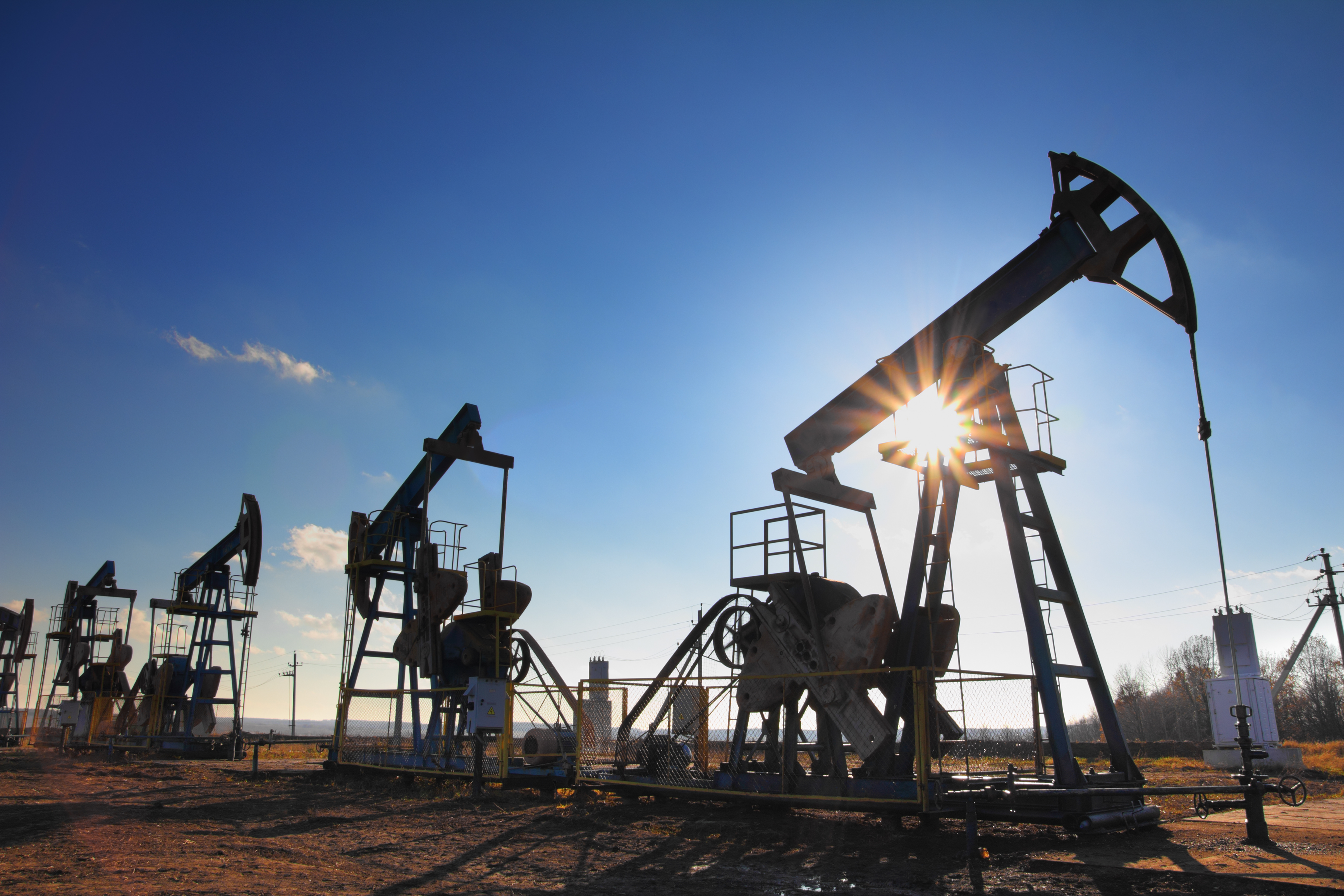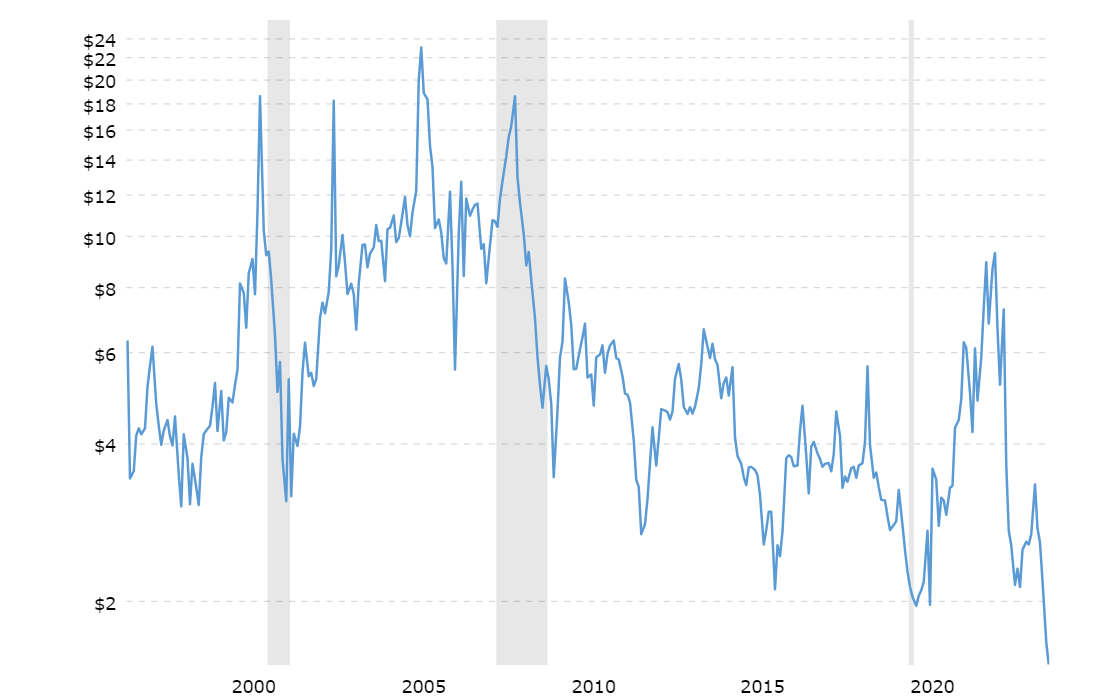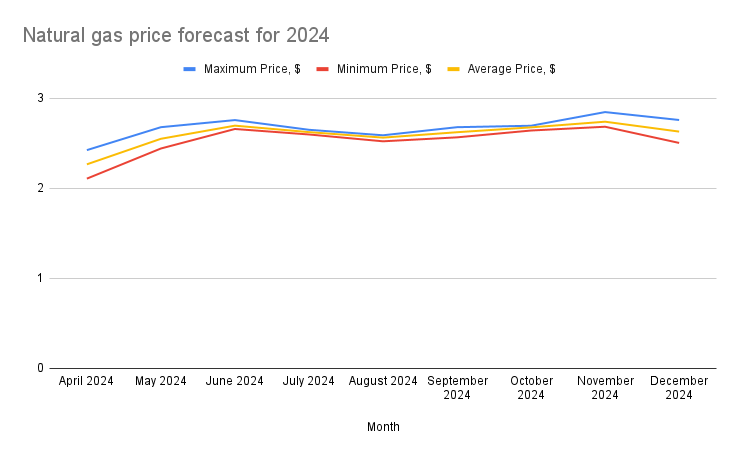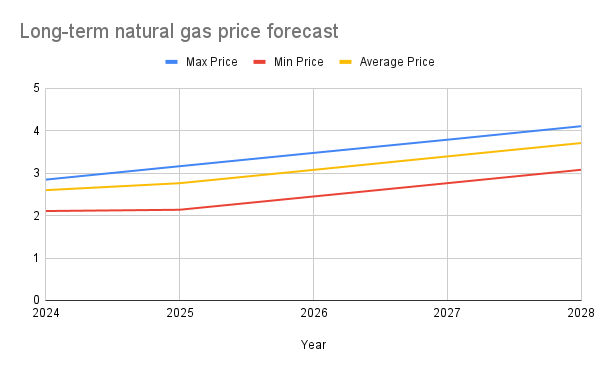Natural Gas Forecast & Price Predictions for 2024, 2025, 2030 and Beyond

Table of Contents
Natural Gas Price Forecast & Price Prediction – Summary
Natural Gas Prices Historical Overview
Natural Gas Price Forecast - Technical Outlook
What Affects Natural Gas Prices?
Short-Term Natural Gas Price Forecast for 2024
Gas Price Forecasts for the Next 5 Years
Natural Gas Forecast for 2030-2050
Conclusion: What Is the Future of Natural Gas?
FAQs
When navigating the ever-changing tides of the global gas markets, it's crucial to grasp the future direction of natural gas prices. This article will provide you with a comprehensive analysis, offering a nuanced natural gas price forecast that recognizes the evolving gas demand. As we navigate through 2024, 2025, 2030, and beyond, our detailed natural gas price predictions will equip you with the necessary insights needed to make informed decisions in a fluctuating landscape.
Natural Gas Price Forecast & Price Prediction – Summary
-
As we go through 2024, the natural gas price forecast indicates a nuanced trajectory. Current data, influenced by factors such as liquefied natural gas (LNG) exports, dry natural gas production rates, and Henry Hub benchmark trends, suggest a potential uptick in prices. This is largely attributed to increased demand in key markets, as well as tightening inventories. In 2024, experts predict Henry Hub natural gas prices to increase from the current level of $1.81 up to $3.55.
- Looking ahead to 2025, the forecast anticipates a continuation of this trend, though with potential fluctuations. In January 2025, some analysts expect the natural gas price to trade at $3.736.
- Looking towards the horizon of the next half-decade and further, the long-term natural gas price predictions hint at a moderating trend. Insights from various analyses suggest that a slowdown in economic expansion could temper demand in the near term, leading to a more balanced market. Over time, as geopolitical tensions ease and supply dynamics evolve, we might witness a gradual softening of prices.
| Year |
Max Price |
Min Price |
Average Price |
| 2024 |
2.847 |
2.107 |
2.599 |
| 2025 |
3.163 |
2.137 |
2.763 |
| 2026 |
3.477 |
2.450 |
3.077 |
| 2027 |
3.788 |
2.764 |
3.395 |
| 2028 |
4.107 |
3.080 |
3.710 |
Natural Gas Prices Historical Overview

The historical movement of natural gas prices can be divided into distinct phases, each characterized by unique conditions and events. Let’s have a closer look.
-
Early 2000s. At first, natural gas prices were pretty steady, but they started to climb as the need for gas to make electricity increased. Sadly, not enough infrastructure meant prices sometimes shot up, showing how tight the balance between supply and demand was.
- Mid-2000s. Hydraulic fracturing and horizontal drilling were game changers that unlocked loads of shale gas. This technological revolution led to a significant increase in dry natural gas production. As a result, the market soon found itself in an oversupply condition, which caused a sharp decline in prices and the necessity to reshape energy policies and natural gas consumption patterns worldwide.
- Impact of the 2008 Financial Crisis. The 2008 financial crisis hit hard, and natural gas prices were no exception. With economies slowing down, the demand for energy dropped, pulling down gas prices. But as things started to improve, so did the demand for gas, slowly pushing prices back up.
- Seasonal Fluctuations and Liquid Natural Gas (LNG) Exports. Seasonal demand, especially during the harsh winter heating season, led to temporary price spikes. The emergence of LNG export capabilities linked domestic prices more closely with the global gas markets, adding a new layer of complexity.
- Recent Geopolitical and Supply Chain Influences. The natural gas world is often shaken by political events and supply chain problems. The recent troubles between Russia and Ukraine are a prime example. Prices jumped because of the uncertainty, showing how sensitive the market is to global events. This has made countries and companies think hard about where they get their energy from.
Natural Gas Price Forecast - Technical Outlook
In the intricate dance of natural gas prices, technical indicators offer a glimpse into potential future movements. Key resistance levels at 1.919, 1.878, and 1.843 delineate the thresholds that might cap upward trends, while pivotal support at 1.767, 1.726, and 1.691 provides a safety net against downward spirals. The market's fulcrum, marked by a pivot point at 1.802, serves as a crucial benchmark for short-term directional bias.
The key technical indicators are shown in the table below.
| Indicator |
Value |
| MA100 (Simple Moving Average) |
1.896 |
| MA200 (Simple Moving Average) |
1.871 |
| RSI(14) (Relative Strength Index) |
46.219 |
| MACD(12,26) (Moving Average Convergence Divergence) |
-0.014 |
| STOCH(9,6) (Stochastic Oscillator) |
65.276 |
| STOCHRSI(14) (Stochastic RSI) |
90.217 |
In the natural gas market, a mixed message emerges from different analysis tools. Moving averages suggest a 'Sell' signal, indicating potential downward pressure on prices. On the other hand, technical indicators paint a more optimistic picture, signaling a 'Strong Buy' and hinting at upward momentum. When these contrasting views are balanced out, the overall signal lands squarely in neutral territory, reflecting a market at a crossroads without a clear directional bias.
What Affects Natural Gas Prices?
There are several factors that play a crucial role in shaping natural gas prices, intertwining to create a complex market landscape. Let’s have a look at them.
-
Production Levels. The amount of natural gas we're able to pump out of the ground is a big deal. Discovering new methods to increase production or finding fresh gas fields can significantly alter the available supply. This can lead to changes in prices, either driving them up or bringing them down, depending on how the supply adjusts.
- Pipelines. Pipelines are like highways, allowing natural gas to travel on to get to its final destination. Any issues or expansions during this transportation process impact how quickly and how much pipeline gas gets to us, influencing prices in the process.
- Demand for Power. Natural gas plays a crucial role in powering our electricity needs. Changes in how much electricity we need, often due to the economy's health or the seasons, can affect how much natural gas we use, which, in turn, can influence its prices.
- Heating in Winter. When it gets cold, we all turn up the heat, which usually means using more natural gas. This jump in demand can really push natural gas prices higher.
- Global Trade. Political events, new trade agreements, or changes in the world's energy needs can make the natural gas price go up or down.
- Henry Hub Prices. As a key reference point for natural gas pricing in North America, the Henry Hub benchmark helps set the price for gas all over North America, and even impacts prices around the world.
- Storage Levels. Significant deviations in natural gas inventories hint that prices might be about to change. Surplus inventories are typically a potential sign of downward pressure on prices, and deficits usually lead to upward trends.
Short-Term Natural Gas Price Forecast for 2024

The natural gas price forecast for 2024 can be tricky, with many variables at play. Not long ago, the conflict between Russia and Ukraine shook Europe's energy sector. There were many worries about a severe gas shortage during the winter of 2022–2023, and real fears that reduced Russian gas supplies might lead to widespread economic turmoil.
Thankfully, those tough times were eased by Europe's mild winter, as well as strategic steps to use less energy and find other gas sources. This approach helped Europe weather the storm, avoiding the worst-case scenarios of gas shortages.
This experience has somewhat eased the fears of a gas crisis, at least for now, showing how the natural gas market is influenced by geopolitical events, weather, and energy policies. Many experts believe that we have already overcome the worst energy crisis, and in 2024, the natural gas market will see a recovery.
According to WalletInvestor.com, natural gas prices in 2024 will be fluctuating in the range of $2.107 - $2.847.
| Month |
Maximum Price, $ |
Minimum Price, $ |
Average Price, $ |
| April 2024 |
2.424 |
2.107 |
2.266 |
| May 2024 |
2.679 |
2.442 |
2.5595 |
| June 2024 |
2.758 |
2.659 |
2.6965 |
| July 2024 |
2.650 |
2.598 |
2.62425 |
| August 2024 |
2.589 |
2.522 |
2.563 |
| September 2024 |
2.679 |
2.566 |
2.623 |
| October 2024 |
2.695 |
2.642 |
2.677 |
| November 2024 |
2.847 |
2.684 |
2.74875 |
| December 2024 |
2.759 |
2.504 |
2.6315 |
Gas Price Forecasts for the Next 5 Years

Forecasting gas prices over the next five years presents a significant challenge. The trajectory of gas demand is closely linked with the global economic landscape, which is currently navigating through a recessionary phase. As the global economy starts to recover in the coming years, experts expect a potential increase in gas demand, especially given natural gas's pivotal role in electricity generation. A strong economy means more electricity usage, which, in turn, boosts the demand for natural gas.
Moreover, the shift towards sustainable energy sources is reshaping the energy sector's dynamics. Natural gas, being one of the cleaner fossil fuels, is likely to see an uptick in usage and demand due to its lower environmental impact. So, as the world leans more towards greener energy alternatives, the natural gas market is expected to grow.
According to WalletInvestor.com, the long-term natural gas price forecast shows the numbers at around $4 at the end of 2028. FitchRatings has a more reserved price prediction, expecting Henry Hub natural gas to trade at around $2.25 in the coming 2-3 years.
Natural Gas Forecast for 2030-2050
Looking ahead to the distant horizon of 2030-2050, forecasting natural gas prices enters a realm where few experts dare to venture. Long-term projections carry inherent uncertainties, and it's rare to find detailed predictions stretching so far into the future. However, a notable prediction from Deloitte suggests that the US natural gas price might hover around an average of $5.40 by the year 2030.
Peering into the future offers a word of caution to traders and analysts. The energy world is changing fast, driven by a move towards renewables, shifts in gas supply and demand, and global politics. The growth of gas pipelines, natural gas's key role in generating power during cold months, and a worldwide effort to cut down on fossil fuel use are all shaping the future of gas prices.
With so many factors impacting the potential gas price, it's crucial for market participants to take long-term forecasts with caution. It's equally important to do your own homework, keeping an eye on market trends and possible changes in the energy landscape.
Conclusion: What Is the Future of Natural Gas?
Natural gas is expected to have a bright future, thanks to a potential increase in demand and its reputation as a cleaner energy choice. As the world leans more towards sustainable energy, natural gas is set to become increasingly important. This is why many experts foresee a gentle rise in its prices, driven by its key role in heating our homes during winter, as well as the growth of gas pipelines.
Right now, natural gas has a rather low price level, which might make it a smart pick for long-term investments, especially if prices start to increase in the coming months. However, just as with any type of investment, it's crucial for traders to do their homework and make sure any moves fit well with their trading approach and risk comfort level. Remember that to make more informed decisions, it’s important to keep up with the latest trends in natural gas production and the overall energy market.
FAQs
What is the future prediction for natural gas?
Experts expect natural gas demand to grow, mainly because it's key for making electricity, and it's cleaner than other fossil fuels. This could lead to steady price increases, but it all depends on how the global market moves.
What is the EU natural gas forecast?
In the EU, natural gas prices might see some ups and downs. Efforts to reduce reliance on Russian gas, boost renewable energy, and build up reserves are in play. These actions, along with a recovering demand, could make prices a bit unpredictable.
What is the future of natural gas in 2024?
For 2024, we might see natural gas demand swing based on how quickly the economy picks up, and how fast renewables catch on. Prices could go up and down, reflecting this uncertain demand and the green energy trend.
Will natural gas prices decrease or increase during 2024?
Natural gas prices in 2024 might fluctuate a bit, showing some increases but also facing market adjustments. The industry is navigating through changing demands, production shifts, and a tilt towards greener energy, making it hard to pin down exact price trends.
Will natural gas prices rise in the next 5 years?
Over the next five years, experts are looking at a potential rise in natural gas prices. This is due to more demand worldwide, especially for LNG and power generation, but this will be balanced out by more production and the influence of renewable energy.
What are the natural gas price predictions for 2030?
By 2030, we could see natural gas prices moderately climbing. This will be shaped by better LNG tech, energy policies favoring cleaner fuels, and the overall demand for energy, though the push for renewable sources might keep prices in check.
